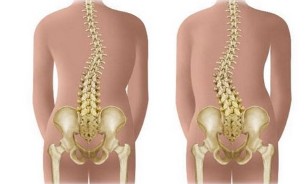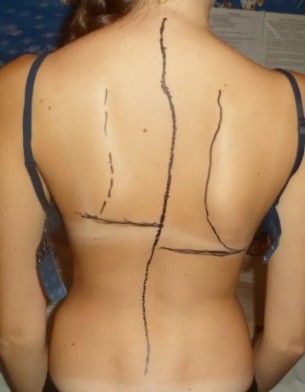In the Greek language is the word "skolios", which translates as "the curve". These words physicians indicate curvature of the spine. Moreover, not every curvature, namely the lateral deviation of the vertical axis of the spine. The fact that the norm of our spine phenomenon is not perfectly smooth. Available in front and rear direction curves (lordosis and kyphosis) protect our spine from undue stress while keeping the body in a certain position when moving and carrying heavy loads. Negative processes in our body develops only in cases where the kyphosis and lordosis are expressed in excess of the permissible limits.

The main problems
However, even a small degree of lateral curves (scoliosis) of the spine is always pathological. And it's not just a cosmetic defect. Although repulsive characteristic appearance in severe or progressive scoliosis is always a tragedy for the person who seeks to live a full quality life. This is especially true for young boys and girls. After all, in childhood and juvenile period (15 – 16 years) diagnosed a significant part of the scoliosis.
The main problem is that due to configuration changes and AB the pit of the chest with marked lateral curvature always suffer from the internal organs (heart, lungs, stomach, liver, intestines, and major blood vessels). In men, reduced tolerance and physical activity in women experiencing problems with conception, pregnancy and birth. Moreover, very often the lateral deformation of the spine – this is just the tip of the iceberg that phenomenon is a symptom of much more serious esni pathology – tumors, tuberculosis, endocrine disorders.
Reasons
So why the spine is deformed? Before answering the question is to determine the types of scoliosis. Essentially scoliosis can be structural and nonstructural. Structural scoliosis develops due to anatomical changes in the structure of the bone tissue of the vertebrae, as well as nearby muscles, nerves, ligaments. Such a curvature can be congenital and acquired, and the share of the latter accounts for about a quarter of all diagnosed scoliosis.
Among the main reasons for the development of structural scoliosis are:

- Vices fetal development, leading and dysplastic disorders of one or more vertebrae
- Congenital abnormalities of the thorax – the lack of ribs, additional ribs
- Congenital abnormality of connective tissue – neurofibromatosis, Marfan syndrome
- Cerebral insufficiency due to cerebral palsy (CP), the anchor and the violation of innervation of certain areas of the spine
- Osteoporosis (rarefaction of bone tissue) of the spine with rickets, diseases of the parathyroid glands, a lack of absorption of calcium from food
- Osteomyelitis of the vertebrae
- Degenerative changes of the cervical, thoracic and lumbar muscles
- Tuberculosis of vertebral injury
- Spinal injury
- Tumors of the spine.
Non-structural scoliosis, as the name implies is a lateral deviation of the axis of the spine when an unmodified structure of the vertebrae. Typically, these scoliosis most often purchased with the exception of those cases when the curvature is of a compensatory character in the congenital anatomic defects of the pelvis or lower extremities. The causes of scoliosis most often are as follows:
- The pelvis and lower extremities
- Congenital defects of the pelvis and lower extremities
- Permanent incorrect posture in schoolchildren
- Diseases of the internal organs asymmetrically with marked pain syndrome
- Inflammation of muscles (myositis)
- Burns, scarring of the soft tissues with any one side.
In these cases, to eliminate curvature of the spine sufficient to cure the underlying disease, and therefore a non-structural scoliosis are easily reversible. In response, some physicians are not inclined to rank the non-structural deformity and scoliosis in General.

In recent years, cases of development of young people scalese unclear reasons. This so-called idiopathic scoliosis. It occurs in teenage years, in a period of rapid growth of the organism. And girls suffer the idiopathic skeletal several times more often than boys. Apparently, this is due to the relatively weak muscles of the back at the female, which is not able to enter into the spine in a full muscular frame. Not the last role in the development of the idiopathic scales plays an unbalanced diet with a low content of calcium salts, the craze of youth sodas. As you know, carbon dioxide in the bubbles and phosphoric acid in the composition of the synthetic inclusions contribute to the leaching of calcium salts from the body.
Of the variety and extent
According to ad localization scoliosis can be cervical, thoracic, lumbar or mixed (cervicothoracic, thoracolumbar). Perhaps the presence of one or more arcs of curvature. In this regard, there are C-shaped scoliosis (1 with arc), S-shaped (with 2 arcs), and Z-shaped (with 3 arcs). Most likely, the presence of 2 or 3 arcs is of a compensatory character. When the C-shaped scoliosis, the axis of the spine is denied. In an effort to compensate for this, the spine is bent in the opposite direction. In this regard, the scoliosis is divided into compensated and decompensated. Compensated curvatures of the spine, a vertical line dropped from the 7th cervical vertebra, passes through the crease between the buttocks.
Curvature of the spine quite often are of a combined character. For example, in the thoracic spine in addition to lateral curvature observed pathological kyphosis, or simply the hump. In these cases, speaking of AB thoracic kyphoscoliosis . In addition, at high degrees scales in addition to the lateral displacement of the vertebrae marked torsion. In literal translation it means twisting. Indeed, when many of the scoliosis is accompanied by twisting of the bone tissue of a vertebra on the vertical axis.
According ot the angle of the arc curvature there are 4 degrees to scales:
- 1 degree angle of curvature of less than 10 degrees. The asymmetry of the eyes is practically not detected. Pay attention to itself, the stooped posture, the uneven level of the shoulder girdle.
- 2 degree angle of curvature is hell 11 and 25 degrees. To this extent already marked by the torsion of the vertebrae. Observed visible to the eye asymmetry of the shoulder girdle and pelvis. Because of abnormal muscle tension is generated in muscle cushion in the lumbar region on the concave side, and in the thoracic region convex.
- 3 the degree of the curve is hell 26 and 50 degrees. Visible deformity of the chest – retraction of the intercostal spaces with the concave side of the curvature and the bulging convex. The weakening of the abdomen, forming the inner Garbo.
- 4 degree angle of curvature of the I exceeds 50 degrees. Pronounced cosmetic defect, and all previous signs. Low tolerance to even small physical activity. In addition to musculoskeletal system internal organs suffer.

The angle can vary depending on the ad situation of the whole, with isolated stable and unstable scoliosis. With an unstable scoliosis is reduced in the supine position, decreases when the load on the spine is torn off. With a stable curvature of the spine, this value remains unchanged.
Symptoms
In the last hour of Orthopaedics often use the term "scoliotic disease". And denote the complex of the negative changes that occur in the body in the curvature of the spine. Typically, scoliosis develops in childhood and adolescence, in the period of formation of the musculoskeletal system. At this time, there is every likelihood that the scoliosis will progress.
Apparently, not last role in increase of angle of curvature of the intervertebral discs play. When the lateral displacement of the disk is experiencing uneven pressure from the vertebral bodies. From the concave side the pressure is more convex with less. As a result the drive wears out even more from scales creates abnormal muscle tension (muscle roller) and torsion of the vertebrae is the phenomenon of the appearance of disc hernia and to further increase the angle of curvature.

Along with the spine in scoliotic illness secondary changes of the rib cage. A so-called rib hump on the convex side of the curvature of the intercostal spaces expand, and with a concave – on the contrary, sink. Scoliosis 4 degrees of deformity of the chest google + is so pronounced that the lower ribs on the side of the curvature in contact with the iliac crest.
Due to severe deformation of the thorax a tour of her during respiration difficult. In the end, the body in patients with severe scoliosis are not receiving the necessary amount of oxygen – develops so-called chronic hypoxia in violation of all metabolic processes in the body. The pathology is exacerbated by the fact that it changes the internal volume and shape of the chest cavity. This interferes with the circulation of blood through the vessels, affects the lungs, the shape of the heart developing chronic cardio-respiratory failure.
Similar changes occur in the organs of the abdominal cavity in the lumbar and thoracolumbar scoliosis. Decreases motility of the stomach and intestines with subsequent enzymatic insufficiency of digestive glands. All this only exacerbates metabolic disorders. These violations often lead and delayed puberty in boys and girls. In addition, due to scales lumbar secondary curves of the pelvis. This creates problems for new moms with pregnancy and childbirth.
Diagnosis
Diagnosis scales, especially big degrees, as a rule, is not difficult. To detect the deformation of the spine often quite ordinary visual inspection. Noteworthy is the apparent curvature of the spine, asymmetry of the shoulder girdle, the angles of vanes of the secondary curvature of the pelvis and shortening of the lower limb on the side of the curve.
In the presence of at least one of these signs are shown x-rays of the spine. On radiographs determine the configuration, degree and localization of perversion. In the course of inspection and x-ray examination can be set, or phenomenon is the scoliosis is compensated and stable. In recent years a proliferation of qualitatively new method for the study of the spine – magnetic resonance imaging (MRI), in which on the monitor screen it is possible to obtain a three-dimensional image of the spine. When significant curvature is required to explore the internal organs – conduct spirometry, electrocardiography, exercise echocardiography, and internal organs.
Treatment
Treatment scales can be conservatively and operational. Yes, conservative methods include medication, massage, physiotherapy, manual therapy. However, note that the final formation of the spine and ends 20 years and after this age the curvature correction is nearly impossible. Scoliosis of 1-2 degrees, the efforts aimed at achieving its original, normal configuration of the spine. Severe scoliosis is a 3 – 4 degree is unattainable, the main thing here is to stabilize the spine and prevent the progression to scales.

Medications (chondro, vitamins, tonic preparations) in the treatment of scales play only a supporting role. To strengthen muscles, eliminate muscle roller, and even to a large extent to stabilize the spine using massage and manual therapy. Good effect is given physiotherapy. But here in case of inadequate physical exertion increases the instability of the spine and scoliosis progresses. Therefore, the complex of exercises is developed for each patient individually, taking into account the localization and severity of the curvature. With a large degree scales contraindicated running, strength exercises, jumping, outdoor games.
Very good result gives the correction position – creates optimal posture, which contributes to the normalization of posture. For this purpose, special devices, orthopedic crib in which young patients spend a significant part of their hour. With the ineffectiveness of conservative measures, the progression of the curvature of the operative treatment, aimed at stabilizing the spine. Surgical correction is not shown in early childhood, it is performed in adolescence, when the spine is almost complete.




























